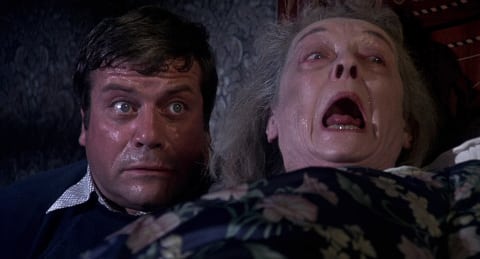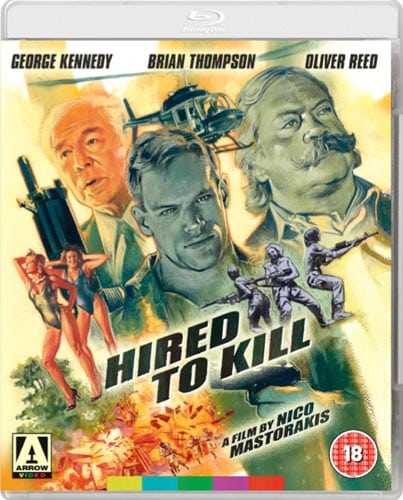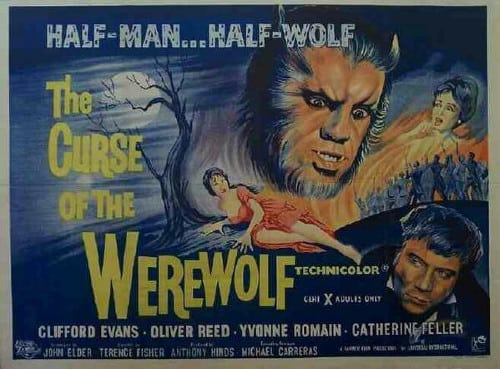Burnt Offerings (1976)
Directed by: Dan Curtis
Written by: Dan Curtis, Robert Marasco, William F. Nolan
Starring: Burgess Meredith, Eileen Heckart, Karen Black, Oliver Reed
USA
AVAILABLE ON DUAL FORMAT BLU-RAY AND DVD: 17TH OCTOBER, from ARROW VIDEO
RUNNING TIME: 116 min
REVIEWED BY: Dr Lenera, Official HCF Critic

The Rolf family – Marion, Ben, 12 year old Davey and elderly Aunt Elisabeth – takes a summer-long vacation at a large, shabby neo-classical 19th-century mansion in the California countryside. The owners, the Allardyce siblings Arnold and Roz, inform the Rolfs of a particularly odd requirement for their rental: their mother will continue to live in her upstairs room, and the Rolfs are to provide her with meals during their stay, but that she’s obsessed with privacy and will not interact with people, so meals are to be left outside her door. Marian begins to succumb to the allure of the ornate house and its period décor, dressing as if she is from the Victorian age, and distancing herself from her family. Of particular interest to her is a room near the bedroom of Mrs. Allardyce, which contains collections of framed portraits of people from different eras and a music box. Then Ben also begins to be affected – but in a different way….
One of the best things about writing for a movie website is that one sometimes gets the chance to see and own for free – as long as I do a review of it – films I’d always meant to wath but had always missed. The funny thing about Burnt Offerings is that as it reached its last ten minutes I recalled that I’d actually seen the ending of the film a great many years ago and never forgotten it. The film seems to get a mixed response from horror fans but I was rather beguiled and chilled by it right from the beginning even if it doesn’t quite entirely fulfill its potential. It’s very much a slow burner and doesn’t even contain much in the way of conventional scares, preferring to rely mostly on simmering tension and a mood of ever worsening dread. It’s one of those ghost stories where, even if it may contain some ghosts [and interpretations probably vary on this], it’s the house that’s the real monster, and this time without any help from the usual stuff like flying cutlery or creepy apparitions or even odd noises. I found this quite refreshing and, because of that, quite unsettling as a result, though as I said if you expect lots of the usual ghost movies things you may be disappointed, and patience is definitely required for a film that if made today would probably be half an hour shorter, while quite a lot is left unexplained too. One thing that also struck me as I watched it is how influential a film it was on some later ghost movies, from The Shining to The House By The Cemetery, its ending particularly influencing the conclusions of both those particular films.
Robert Marasco published his novel Burnt Offerings in 1973, and William F. Nolan wrote a screenplay which was going to be filmed by Bob Fosse until the latter got the green ligh to make Cabaret. Producer/director/co-writer Dan Curtis, who’d made a name for himself with his TV series Dark Shadows and horror TV movies like The Night Stalker and The Norliss Tapes, wanted to take over, but could only get the money to do so when he sold the rights to the novel The Hoods by Harry Grey to Sergio Leone [who turned it into Once Upon A Time In America]. He’d read the novel when it first came out and hated its open-ended conclusion, so the first thing he did was write a different ending, while the flashbacks were based on a childhood experience of seeing a chauffeur laughing outside a funeral parlour which disturbed him deeply. The film was shot entirely on location, mostly inside the Dunsmuir House in Oakland, California which also featured in lots of other films like Phantasm, A View To A Kill and So I Married An Axe Murderer. Karen Black and Betty Davis failed to get on, mostly because Davis thought Black was disrespectful and unprofessional. Just before release, Curtis removed an entire 15-minute opening with the family in New York because it was “boring”. The film got a mixed reception from critics and was hardly a hit with audiences either but seemed to be bwell remembered by many people.
The ominous score helps set the right mood as the opening credits play over the Rolf’s arriving at the Allardyce house. Now I’m fully aware that modern houses can work well in ghost pictures, but for me there’s something about much older abodes that makes them much creepier, and this one is just fantastic with all its dark rooms and Victorian stuff – you just know that the house has had a long history. You can almost feel it. In fact, you can almost smell it. The first face that greets the Rolf’s when they knock on the door of the house is actually that of the handyman, but it’s obvious within a minute that the Allardyce siblings, one of whom is played by Burgess Meredith who, obviously wanting to make the most of a tiny part, hams it up rotten, are a bit loopy and I couldn’t understand why Marion and Ben don’t just get the hell out of the place, but hey this is a horror movie so, after going home for a bit to think about it [a new film would probably just have them think about it for a few seconds in the house rather than have them go back home], they decide to take care of the house for the duration of the summer, even though they have to live with Arnold and Roz’s mother, who never comes out of her room, and are told by Arnold: “The house takes care of itself”.
Instead of the conventional spooky happenings, we start to see people being gradually affected by the house. Marion falls in love with it and begins to lose herself as the house is basically seducing her. She spends much of her time in the room next to that of Mrs. Allardyce, and as she sits there in Victorian garb looking at photographs the film gives out quite a strong sense of the past, a really haunting feeling despite there not actually being any ghosts – well, not ‘proper’ ones. Ben is affected rather differently and a really well put together sequence cuts back and forth from Marion polishing pictures, lost in her world, while Ben’s messing around with Davey in the swimming pool takes a nasty turn as he tries to kill him in quite an upsetting moment that is quite hard to watch. Ben mostly just feels really agitated, but unlike Marion is fully aware of this and realises that something is clearly wrong way before Marion does. Then there’s Aunt Elizabeth, who seems to be affected like both Marion and Ben are at times but more than that is being gradually drained of life. Surprisingly – considering how often horror films go down the spooky child route – Davey seems to be unaffected, which makes matters more intense. And ironically in this strange tale of transformation, the house seems to get ‘better’ as its occupants get ‘worse’, the first big sign of this being when the swimming pool suddenly seems new and clean.
While it has a tremendous build up, Curtis really being good at winding up the suspense until it’s almost unbearable, the climax is a bit of a let down though it contains a death scene you will most definitely remember [well I certainly did for at least two decades]. It also leaves a hell of a lot unexplained, but in a way that’s good as you may be thinking about things such as what exactly are Arnold and Roz for a while afterwards. While virtually avoiding the usual ghost movie devices, Ben’s dream of seeing an extremely creepy chauffeur during his mother’s funeral, and his subsequent visions of the apparition, are quite unnerving, the character’s evil smile being especially spine chilling. He reminded me of that scary Reverend Kane from Poltergeist 2 . There are a couple of surprising, if brief, moments of special effects which are reasonably convincing, though much of the film – and I don’t think that this is anything to do with the efforts of Arrow who almost always seem to do the best job they can on a film – appears to have been shot with varying degrees of soft focus, and also flits back and forth between a rather drab look and a more colourful one, the latter most notably during some red-dominated moments in the room Marion likes to be in. Overall the direction of Curtis is straightforward but reasonably cinematic, and despite being mainly a TV director he doesn’t fall into the trap of using too many close-ups like many of his ilk did back then.
The acting in this film is first rate all-round, though it had to be considering that most of the folm consists of just four characters. Oliver Reed [who seems really committed and- dare I say it – sober] does that brewing anger that he does so well while also being allowed to show a sensitive side occasionally, Karen Black [who was pregnant at the time of filming, something which is sometimes still obvious no matter how much they try to conceal the fact] resists the temptation to overdo the idea of going into a trance and even makes her situation slightly relatable, Bette Davis, in a really good late performance which deserves to be mentioned far more than it is, is allowed to both have a lot of fun and be highly intense and emotional, and Lee Montgomery shows himself as a terrific child actor and really does seem frightened at times. The music score by Curtis’s usual composer Robert Cobert is very effective indeed, giving the proceedings an extra chill and finally erupting into great barnstorming stuff towards the end. One especially good device he employs is have some of the instruments in the higher registers do a sliding pattern that sounds like distorted bird song. It’s really sinister, but by contrast his music box theme is very melancholy. Not quite a neglected all-time classic but not far off, Burnt Offerings should really reward if you fancy a ghost story that’s a bit different, and may actually seem scarier [it certainly seems that way to me] immediately after you’ve seen it rather than while you are watching it, though of course it’s often as nice and as satisfying to feel some slight, subtle chills as it is to be terrified out of our wits anyway.
Arrow have clearly done what they can with the soft and often hazy [which reportedly was awful in the DVD] look of Burnt Offerings. A few specks of dirt can be seen during the title sequence, but after that the print looks extremely clean. The release ports over all the special features from the Region ‘A’ Kino Lorber Blu-ray. The first of the two audio commentaries with Dan Curtis, Karen Black and William F. Nolan is full of interesting tidbits and feels very relaxed and natural if a bit too self-congratulatory in places. The second one with film expert Richard Harland Smith is unsurprisingly a bit more academic but never too much so. As as often the case, you can sometimes tell he’s reading from notes, but he provides a great deal of information and insight if sometimes spining off into slightly different territory such as the history of ghost stories, which is still usually interesting. Out of the three interviews, I watched the one with Lee Montgomery where he amusingly recalls being initiated into Reed’s entourage and unsurprisingly got rather drunk, causing his mother to tell Reed off. This is another strong package from Arrow for a rather underrated horror film which I wish I’d seen far sooner.
SPECIAL EDITION CONTENTS
*High Definition Blu-ray (1080p) and Standard Definition DVD presentation of the feature, transferred from original film elements by MGM
*Original uncompressed PCM mono audio
*Optional English subtitles for the deaf and hard of hearing
*Audio commentary by film historian Richard Harland Smith
*Acting His Face, an interview with actor Anthony James
*Blood Ties, an interview with actor Lee Montgomery
*From the Ashes, an interview with screenwriter William F. Nolan
*Portraits of Fear, an animated gallery of promotional materials and behind-the-scenes stills
*Theatrical trailer
*Reversible sleeve featuring original and newly commissioned artwork by Haunt Love
*First pressing only: Collector’s booklet featuring new writing on the film by critic Kat Ellinger









Be the first to comment